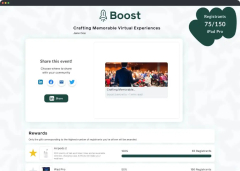How To Avoid Event Marketing Pitfalls Through Nontraditional KPIs
- Written by Michael Rodriguez
- Published in Blog
Event marketing has quickly become one of the major sources of revenue for B2B companies, with many marketing and sales teams using creative digital events and webinars to market products, engage and educate buyers and meet with prospects.
However, many marketers are still struggling to figure out how successful and effective their events actually are. And a question they should ask is “How can I effectively measure my event’s ROI and impact on target buyers?”
Demand Gen Report recently sat down with Brian Gates, SVP of Marketing & Strategy at event marketing platform RainFocus to explore different methods of measuring event ROI and how they relate to hosting virtual events.
In the second part of this three-part blog series (check out the first here!), Gates shared insights into best practices for measuring event ROI and the challenges with measuring event impact.
Too Many Hands In The Event Data Jar
When measuring event ROI, many marketers tend to track success by operational standards such as watch time, number of registrants, number of shares on social media, etc.
Event marketers are still using registration codes and reporting centers to glean insights and measure their success, often being processed by out-of-house orgs reporting back on leads and customer insights. With event data being managed by multiple parties with unaligned goals, engagement data can become stale and leads could get cold.
“Virtual events struggle with the same issues,” said Gates. “In many cases, it becomes even more frustrating because the engagement data that can be gathered is so much richer. Virtual events are not a collection of webinars but rather an ecosystem of attendees, sponsors and stakeholders all interacting with each other. Enterprises have either been forced to cobble together technologies or utilize legacy virtual event solutions to deliver that ecosystem.”
Another major issue facing event marketers is the underutilization of insights, with many event marketing teams completely unaware of what insights they have or how to take action on them.
Gates cited internal misalignment as the main cause, as various marketing teams may be collaborating during an event but are focused on two different goals. Without all teams agreeing on the goals of an event, they will not be able to determine whether the event data is beneficial or if the event generated ROI to begin with. The data itself can also become siloed, out of date and ultimately useless.
“The data that does get processed tends to be underutilized by the marketing teams, in large part because they don’t know what they have,” Gates explained. “Aligning session engagement or other behavioral event data to marketing outcomes never happens because it sits between two independent teams (digital marketing and event marketing), leaving event attribution a mystery. With no way to quantify attribution of event behaviors, true ROI is more of a feeling than a science.
Determining Event ROI Through Customer Retention & Awareness
Gates highlighted three specific KPIs event marketers should use to measure their event ROI and take advantage of event engagement data, including:
- Brand Awareness: By driving exposure with their brand, marketers can measure an event’s impact on customers, prospects and the market. Common KPIs include attendee growth, repeat viewings, the range of content engagement and social media reach.
- Customer Retention & Expansion: Marketers can measure the connection between their existing customers and the depth of product/service consumption, focusing on the conversations, event engagement rates and the number of sales interactions.
- Pipeline Growth: Marketers can measure event ROI by calculating the number of prospects with buying intent captured and nurtured to determine if they have accelerated their buying cycle.
“These are some common event goals and metrics that can be measured to determine event success,” said Gates. “These metrics are standard across goal type and can be broken out by event attendance range and key categories for the best possible insights.”
Gates also explained that the simplest way for event marketers to overhaul their KPI measurement is to focus on one unified goal, having all teams in-house and adhering to the same framework, goals and data for this same purpose: generating leads and increasing ROI.
“By having a shared event goal, marketing teams can determine how you measure the value of an event and in some cases, your event will have a broad range of goals per audience,” he said.









